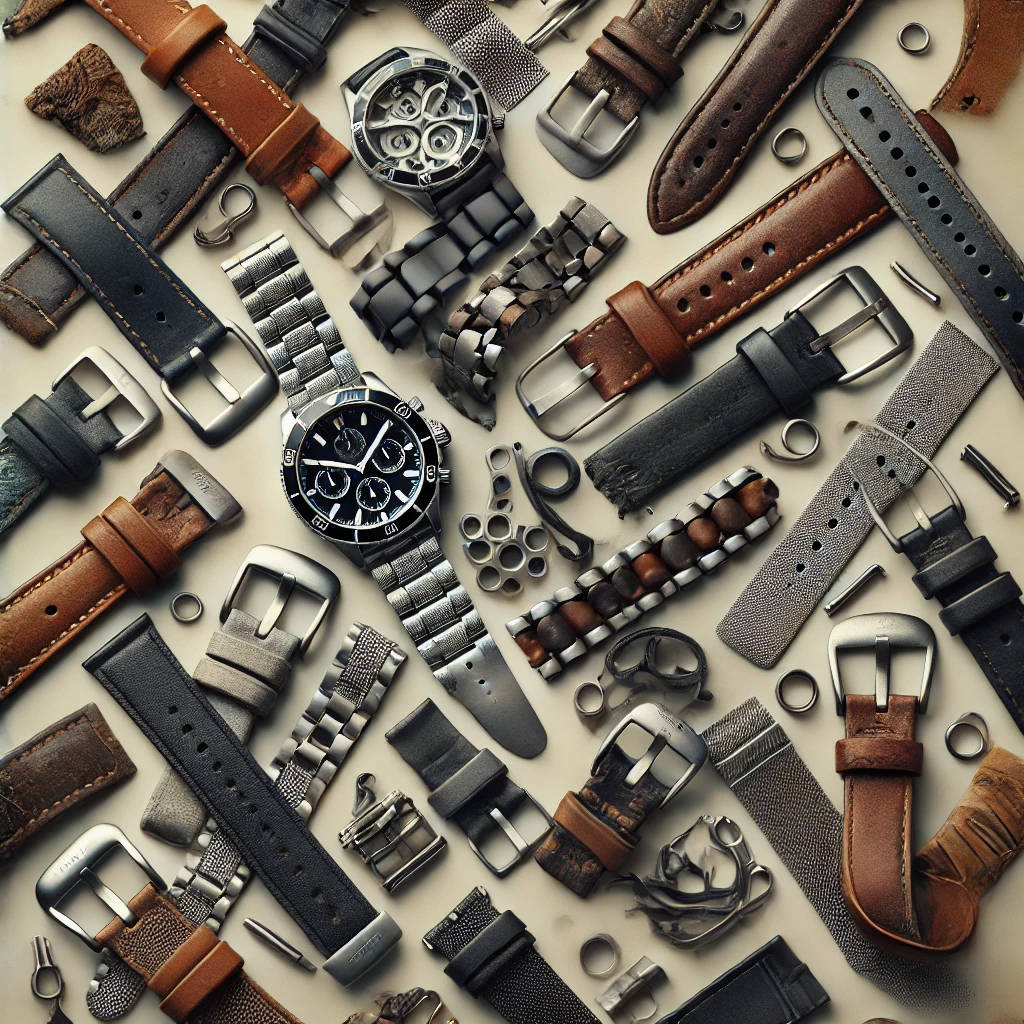Introduction
A watch strap is not only a functional element but also an important part of style. Choosing the right strap can significantly change the appearance of the watch and affect its comfort when worn. In this article, we will examine the main watch strap materials, exploring their unique characteristics, benefits, and drawbacks, to help you choose the right option.
1. Metal Straps
Metal straps, also known as metal bracelets, are a popular choice in both casual and luxury timepieces. They are valued for their durability, premium appearance, and versatile design, and are typically crafted from stainless steel, titanium, or gold. Each material has unique qualities that make it suitable for different preferences, occasions, and wrist types.
1.1 Stainless Steel
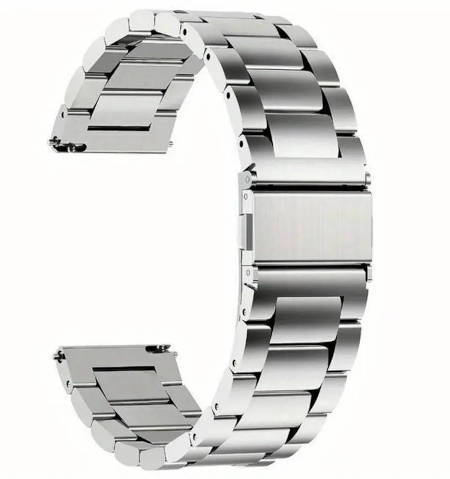
Stainless steel watch straps are the most common and widely used metal option. Known for their robust construction, corrosion resistance, and modern style, they suit everything from tool watches to dress timepieces. The links can vary in finish—from brushed to polished—and are often adjustable for a tailored fit.
- Advantages: Strong and long-lasting, resistant to rust and moisture, minimal upkeep, timeless appearance.
- Disadvantages: Can feel heavy on the wrist, may feel cold in cooler weather.
Best for: Everyday wear, professional settings, divers, chronographs, and dress watches.
1.2 Titanium
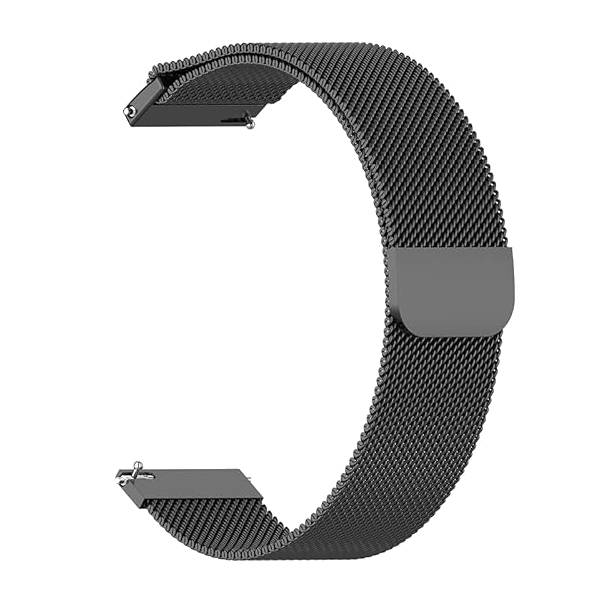
Titanium watch straps offer a lightweight yet strong alternative to stainless steel. They are ideal for those who prefer the look and feel of metal but want a more comfortable option—especially for larger watches.
- Advantages: Around 40% lighter than steel, hypoallergenic, highly resistant to corrosion and saltwater.
- Disadvantages: Typically more expensive, surface may scratch more easily than steel (though many feature protective coatings).
Best for: Sports watches, aviation watches, outdoor use, and those with sensitive skin.
1.3 Gold
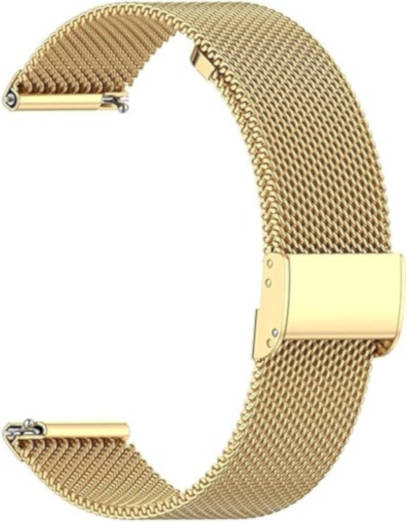
Gold watch straps represent the pinnacle of luxury and are often found in high-end or vintage models. Usually made from 18K solid gold or gold-plated alloys, these straps add an unmistakable touch of sophistication and prestige.
- Advantages: Luxurious aesthetic, excellent investment value, timeless elegance.
- Disadvantages: Expensive, prone to scratches and dents, requires gentle handling and regular cleaning to maintain shine.
Best for: Formal occasions, heirloom or dress watches, collectors of luxury timepieces.
Metal watch bands offer unmatched longevity and classic appeal, but it’s important to choose the right type based on your lifestyle, comfort preferences, and style goals. Whether you prioritize durability, weight, or a luxurious finish, there's a metal strap material suited for every watch lover.
2. Leather Straps
Leather straps are a timeless classic in the world of horology. Known for their elegance, comfort, and refined character, leather watch bands are a favorite among collectors and professionals alike. They’re available in a wide range of styles and finishes—from smooth calfskin to exotic crocodile and ostrich leather—making them a versatile option for both casual and formal wear.
2.1 Calfskin Leather

Calfskin leather is one of the most popular and accessible materials for watch straps. It offers a smooth texture, soft feel, and an effortlessly elegant look, making it ideal for both modern and vintage-style watches. Available in matte, glossy, or textured finishes, calfskin can complement everything from minimalist dress watches to everyday wearers.
- Advantages: Soft and supple, comfortable on the wrist, readily available in many styles and colors, develops a beautiful patina over time.
- Disadvantages: Sensitive to water and humidity, may wear faster with frequent exposure to sweat or rough use.
Best for: Dress watches, classic styles, business and casual attire.
2.2 Crocodile and Ostrich Leather
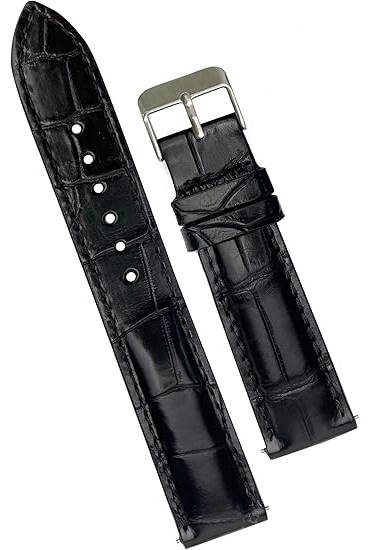
For a more luxurious and distinguished aesthetic, exotic leathers like crocodile and ostrich offer unmatched visual appeal and exclusivity. These materials are prized for their distinct textures, craftsmanship, and status.
-
Crocodile Leather: Features a signature pattern of scales, offering a refined and formal look. Commonly used in luxury Swiss watches and high-end timepieces.
-
Ostrich Leather: Recognizable by its dotted quill patterns, ostrich leather is softer and has a unique, slightly bumpy texture that sets it apart.
-
Advantages: Premium appearance, luxurious feel, strong and long-lasting when properly cared for.
-
Disadvantages: Expensive, requires occasional conditioning and careful maintenance to avoid drying or cracking.
Best for: Luxury watches, collectors, formal occasions, and those who value artisanal details.
Leather watch straps are ideal for those who want classic sophistication without compromising on comfort. Whether you’re dressing up for an event or wearing your watch daily, the right leather strap can transform the entire look and feel of your timepiece.
3. Fabric Straps
Fabric straps are the go-to choice for casual, sporty, and adventure-ready watches. Known for their comfort, breathability, and rugged appeal, these straps are commonly found on military, field, and dive watches. Popular options like NATO and Perlon straps combine function and fashion in a lightweight, low-maintenance package.
Fabric straps are typically made from synthetic materials like nylon or perlon, although some are woven from natural fibers. They’re perfect for active lifestyles and warmer climates where breathability and water resistance are essential.
3.1 NATO Straps

Originally developed by the British Ministry of Defence, the NATO strap is a hallmark of military-inspired watch design. Made from tightly woven nylon, it’s appreciated for its rugged durability, secure fit, and simple installation that passes under the spring bars, offering added security in case a pin breaks.
- Advantages: Extremely durable, water-resistant, quick-drying, budget-friendly, easy to change.
- Disadvantages: Not ideal for formal wear, can add extra height to the watch.
Best for: Field watches, dive watches, military-style or casual timepieces.
💡 Strap choice goes beyond materials. A NATO strap complements a rugged field watch, while a crocodile leather strap enhances a luxury dress watch.
Read our guide to watch types to learn more.
3.2 Perlon Straps
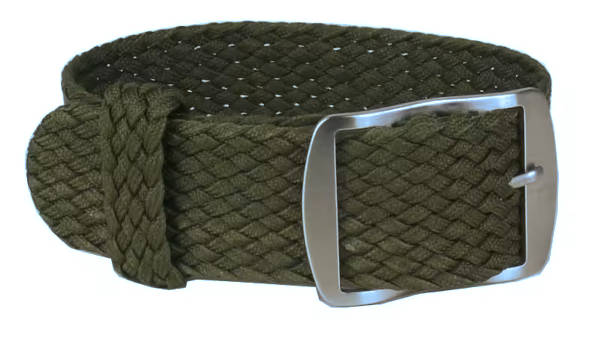
Perlon straps are another lightweight and breathable option, made from braided synthetic fibers. Their woven texture and adjustable pin-and-hole-free design offer a unique look and exceptional flexibility.
- Advantages: Incredibly breathable, adjustable to any wrist size, resistant to water and sweat, distinctive woven appearance.
- Disadvantages: Less formal, may not suit luxury timepieces.
Best for: Summer wear, active lifestyles, minimalist or casual watches.
Fabric watch straps are an excellent choice for versatility, comfort, and affordability. Whether you’re hitting the trail, the beach, or just running errands, NATO and Perlon straps provide a casual, cool alternative to leather or metal. Their quick-swap capability also makes them ideal for changing your watch’s style on the go.
4. Rubber Straps
Rubber watch straps are a top choice for sports, diving, and outdoor adventures. Known for their water resistance, flexibility, and durability, rubber straps are engineered to perform in extreme environments—whether you're swimming, hiking, or hitting the gym.
There are two main types of rubber straps: silicone and natural rubber. While they serve similar purposes, each has its unique feel and long-term performance.
4.1 Silicone Straps
![]()
Silicone watch straps are made from synthetic rubber that’s ultra-soft and flexible. These straps are a go-to for those who prioritize comfort and affordability in an active lifestyle. Their modern, sporty design pairs perfectly with digital and fitness watches.
- Advantages: Lightweight, waterproof, soft on the skin, hypoallergenic, and very affordable.
- Disadvantages: Can attract dust and lint, less breathable, and not suited for dressy occasions.
Best for: Fitness trackers, dive watches, smartwatches, or any sporty timepiece.
4.2 Natural Rubber Straps

Natural rubber straps, like those used by high-end dive watch brands (think Seiko or Panerai), offer superior durability and resilience. They tend to be firmer than silicone but hold up better under prolonged use and extreme conditions.
- Advantages: Excellent resistance to saltwater, sweat, heat, and UV exposure; long-lasting with proper care.
- Disadvantages: May lose elasticity over many years; typically more expensive than silicone.
Best for: Professional dive watches, adventure watches, or rugged everyday wear.
Rubber straps strike the perfect balance between functionality and casual style. If you lead an active life or want a strap that can handle sweat, surf, or storms—rubber is your best friend. They're not just practical—they're also evolving in design, with textured finishes, colored variants, and quick-release systems that make swapping straps a breeze.
5. Comparison of Watch Straps by Parameters
Choosing the right watch strap often comes down to balancing comfort, durability, water resistance, and style preferences. To make this decision easier, here’s a side-by-side comparison of the most popular watch strap materials—metal, leather, fabric, and rubber—based on key performance and lifestyle criteria.
| Parameter | Metal Straps | Leather Straps | Fabric Straps (NATO, Perlon) | Rubber Straps |
|---|---|---|---|---|
| Durability | Excellent — corrosion-resistant, long-lasting | Moderate — prone to wear and cracking over time | Moderate — may fray or fade with use | High — strong and tear-resistant |
| Comfort | Can be heavy and cold, especially in winter | Soft, molds to wrist, breathable | Lightweight and breathable | Soft, flexible, great for active wear |
| Style Versatility | Great for dress and business watches | Elegant and stylish, ideal for formal settings | Casual look, less suited to formal wear | Primarily sporty and casual in appearance |
| Water Resistance | Low — can rust or discolor over time | Low — water damages leather | High — dries quickly and resists water | Excellent — perfect for swimming, diving |
| Price Range | Medium to high — varies by material (steel, gold, titanium) | Medium to high — varies by leather type (calfskin, exotic) | Budget-friendly for most watch owners | Budget to mid-range depending on quality |
| Maintenance Required | Low — just occasional wiping | Moderate — needs conditioning and cleaning | Very low — easy to wash and dry | Low — rinse or wipe clean easily |
| Ease of Replacement | May require tools or links adjustment | Usually needs some assistance | Extremely easy — no tools required | Tool-free in most modern straps |
| Skin Sensitivity | Usually hypoallergenic (especially titanium) | Natural materials may cause allergies | Hypoallergenic — great for sensitive skin | Hypoallergenic and breathable |
Quick Takeaways:
- Choose a metal strap if you prefer a timeless, professional look and value longevity.
- Opt for leather when comfort and elegance matter most—perfect for business or formal occasions.
- Pick a fabric strap if you're going for casual, breathable, and lightweight wear—ideal for everyday or travel watches.
- Go with rubber if you're into sports, swimming, or need a worry-free strap that can take a beating.
Still unsure? The best watch strap often depends on your lifestyle, climate, and the occasion. Many watch collectors keep multiple strap options on hand to match different needs and outfits.
6. How to Choose the Right Strap
Choosing the perfect watch strap is about more than just appearance — it’s about finding the ideal balance between function, comfort, and style. Whether you’re selecting a strap for a new timepiece or refreshing an old favorite, here are the key factors to consider:
1. Match the Strap to Your Watch Style
The strap should complement your watch’s overall design. A sleek leather strap enhances a minimalist dress watch, while a rugged NATO strap pairs naturally with a field or military watch. Consider the watch’s case size, color, and dial layout when making your choice.
- Dress Watches pair best with leather or slim metal straps.
- Dive and Sports Watches look great with rubber or NATO straps.
- Smartwatches offer the most flexibility — choose silicone for workouts or leather for work settings.
2. Think About the Purpose and Occasion
Ask yourself: Where and how will I wear this watch?
- Everyday wear: Fabric or rubber straps are comfortable, breathable, and low maintenance.
- Formal events: Leather and polished metal offer an elegant, sophisticated look.
- Outdoor or sports use: Opt for water-resistant materials like silicone, natural rubber, or nylon.
Choosing the wrong strap for the setting can make your watch look out of place — or wear out faster than expected.
3. Prioritize Comfort and Personal Style
A watch strap should feel as good as it looks. Consider your wrist shape, sensitivity to certain materials, and the climate where you live.
- Do you have a sensitive wrist? Look for hypoallergenic materials like titanium or silicone.
- Do you live in a hot climate? Breathable fabric or perforated rubber will prevent sweat buildup.
- Prefer a vintage or classic aesthetic? A distressed leather strap might be your best fit.
- Want to switch up your look often? Consider watches with quick-release spring bars for easy strap changes.
The right strap can transform how a watch feels, fits, and is perceived — so take your time exploring options. Remember, your watch is more than just a timekeeping tool — it’s a reflection of your personality.
Conclusion
The material of a watch strap isn’t just a detail — it plays a crucial role in defining the watch’s comfort, durability, and overall appearance. Whether you prefer the classic elegance of leather, the rugged strength of metal, the sportiness of rubber, or the casual flexibility of fabric, understanding the features of each strap type helps you make a smarter, more personalized choice.
By considering your lifestyle, wrist comfort, and the intended use of the watch, you can match your strap not only to your timepiece but also to your day-to-day needs. And remember, many straps are interchangeable — so you don’t have to settle for just one look.
A well-chosen strap enhances the watch, complements your style, and ensures that your timepiece is truly yours.
Choosing the right watch strap material can significantly affect both the comfort and style of your timepiece. Different materials—from leather and metal to rubber and fabric—offer varying levels of durability and elegance. To ensure the strap complements your wrist perfectly, consider also the size of the watch you're pairing it with. For advice on selecting the ideal watch size, see our article on How to Choose the Right Watch Size for Your Wrist?.
The type of watch you own, whether it's a dress watch, sports watch, or diver, also plays a crucial role in determining the best strap material. Each style calls for specific characteristics in a strap to match both function and appearance. Discover more in The Ultimate Guide to Watch Types: Dress, Sport, Diver, and More.
In today’s world, watches are not just tools for timekeeping—they have become important fashion accessories. Choosing the right strap material can enhance your watch’s role as a style statement. Dive into the debate on whether watches are primarily timing tools or fashion accessories in our article Now Watches: A Timing Tool or a Fashion Accessory?.
